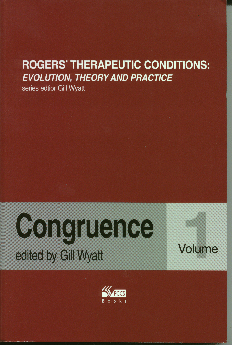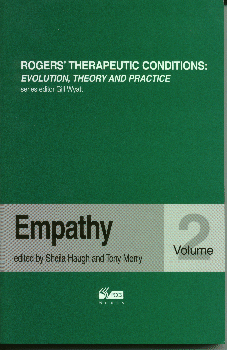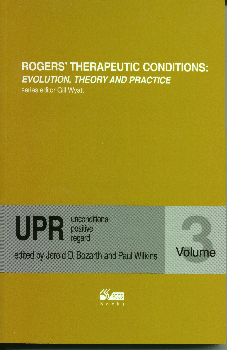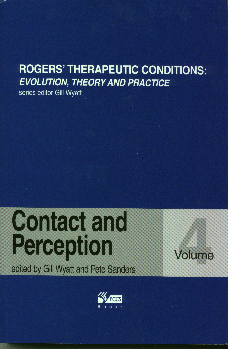Gill
Wyatt (Ed.)
Rogers'
Therapeutic Conditions:
Evolution, Theory and Practice
4 volumes
![]()
![]() Description
of the series
Description
of the series![]()
![]()
![]() Vol.
1
Vol.
1
![]() Vol.
2
Vol.
2
![]() Vol.
3
Vol.
3
![]() Vol.
4
Vol.
4
Chapters by
Peter F. Schmid:
![]() Vol. 1: Peter F. Schmid,
Authenticity:
The person as his or her own author. Dialogical
and ethical perspectives on therapy as an encounter relationship. And beyond.
Vol. 1: Peter F. Schmid,
Authenticity:
The person as his or her own author. Dialogical
and ethical perspectives on therapy as an encounter relationship. And beyond.
![]() Vol 2:
Peter F. Schmid, Comprehension: the art
of not-knowing. Dialogical and ethical perspectives on empathy as dialogue in personal and person-centred relationships
Vol 2:
Peter F. Schmid, Comprehension: the art
of not-knowing. Dialogical and ethical perspectives on empathy as dialogue in personal and person-centred relationships
![]() Vol 3:
Peter F. Schmid,
Acknowledgement:
the art of responding. Dialogical and ethical perspectives on the challenge of
unconditional personal relationships in therapy and
beyond
Vol 3:
Peter F. Schmid,
Acknowledgement:
the art of responding. Dialogical and ethical perspectives on the challenge of
unconditional personal relationships in therapy and
beyond
![]() Vol 4: Peter F. Schmid,
Presence:
Im-media-te co-experiencing and co-responding. Phenomenological,
dialogical and ethical perspectives on contact and
perception in person-centred therapy and beyond.
Vol 4: Peter F. Schmid,
Presence:
Im-media-te co-experiencing and co-responding. Phenomenological,
dialogical and ethical perspectives on contact and
perception in person-centred therapy and beyond.
 VOLUME 1
VOLUME 1
Gill Wyatt (Ed.), Congruence
Ross-on-Wye
(PCCS)
2001
Paper £
17.50 • [26 EUR]
ISBN
1-898059-29-2
242+x pp.
Contributions by
Jerold S. Bozarth Barbara Temaner Brodley
Ivan Ellingham Soti Grafanaki Leslie S. Greenberg/Shari M. Geller
Sheila Haugh • Mia Leijssen Germain Lietaer Tony Merry Peter F. Schmid
• Julius Seeman Per-Anders Tengland Gill
Wyatt
Contents:
PART ONE: Historical Perspectives
1. Haugh, Sheila A Historical Review of the Development of the Concept of Congruence in Person-Centered Therapy
2. Grafanaki, Soti What Counselling Research has Taught us About the Concept of Congruence: Main Discoveries and Unresolved Issues
PART
TWO: Theory and Practice
3. Lietaer, Germain Being Genuine as a Therapist: Congruence and Transparency
4. Temaner Brodley, Barbara Congruence and its Relation to Communication in Client-Centered Therapy
5. Wyatt, Gill The Multifaceted Nature of Congruence Within the Therapeutic Relationship
6. Ellingham, Ivan Carl Rogers Congruence as an Organismic, not a Freudian, Concept
7. Haugh, Sheila The Difficulties in the Conceptualisation of Congruence: A Way Forward with Complexity Theory?
8. Greenberg, Leslie S. / Geller, Shari M. Congruence and Therapeutic Presence
9. Leijssen, Mia Authenticity Training: an Exercise for Therapists
PART
THREE: The Wider Context and Links to the Other Conditions
10. Tengland, Per-Anders A Conceptual Exploration of Incongruence and Mental Health
11. Merry, Tony Congruence and the Supervision of Client-Centered Theapists
12. Bozarth, Jerold D. Congruence: A Special Way of Being
13. Seeman, Jules On Congruence: A Human System Paradigm
15. Wyatt, Gill Congruence: A Synthesis and Implications
|
 VOLUME 2
VOLUME 2
Sheila Haugh and
Tony Merry (Eds.), Empathy
Ross-on-Wye
(PCCS)
2001
Paper £
17.50 • [26 EUR] ISBN 1-898059-30-6 256+x pp.
Contributions by
Richard
Baughan/Tony Merry Ute Binder/Johannes Binder Art Bohart Jerold D.
Bozarth Barbara Temaner Brodley Mick Cooper
Sheila Haugh/Tony Merry
Garry Prouty Nathaniel J. Raskin Laura
North Rice Peter
F. Schmid John Shlien
Per-Anders Tengland
Margaret Warner Mike
Worrall Fred Zimring
Elisabeth Zinschitz
Contents:
PART
ONE: Historical Perspectives
1. Nathaniel J. Raskin The History of Empathy in the Client-centered Movement
2. Barbara Temaner Brodley Observations of Empathic Understanding in a Client-centered Practice
PART
TWO: Theory and Practice
3. John Shlien Empathy in Psychotherapy: Vital Mechanism? Yes. Therapists Conceit? All too Often. By Itself Enough? No.
5. Per-Anders Tengland Empathy: Its meaning and its place in a theory of therapy
6. Fred Zimring Empathic Understanding Grows the Person . . .
7. Art Bohart Emphasising the Future in Empathy Responses
8. Laura North Rice The Evocative Function of the Therapist
9. Jerold D. Bozarth Beyond Reflection: Emergent modes of empathy PLUS An Addendum to Beyond Reflection: Emergent modes of empathy (August 2001)
10. Garry Prouty A New Mode of Empathy: Empathic Contact
11. Ute Binder and Johannes Binder A Theoretical Approach to Empathy
12. Margaret Warner Empathy, Relational Depth and Difficult Client Process
13. Elisabeth Zinschitz Understanding What Seems Unintelligible
14. Mike Worrall Supervision and Empathic Understanding
PART
THREE: The Wider Context and Links to the Other Conditions
15. Mick Cooper Embodied Empathy
16. Richard Baughan and Tony Merry Empathy: An evolutionary/biological perspective
17.
Sheila Haugh and Tony Merry
Empathy
in Context: The joining of the streams
John Shlien, USA, November 2001
|
 VOLUME 3
VOLUME 3
Jerold Bozarth and Paul Wilkins (Eds.), Unconditional Positive Regard
Ross-on-Wye
(PCCS)
2001
Paper £17.50 • [26 EUR]
ISBN
1-898059-31-4 236+xiv pp.
Contributions by
Gerald
Bauman Jerold Bozarth Barbara Temaner
Brodley Elizabeth Freire Mary N. Hendricks
James R. Iberg Armin Klein Toro Kuno
Germain Lietaer Kathy Moon Judy Moore
Garry Prouty Bert Rice Ruth Sanford
Peter F. Schmid Carolyn Schneider Patricia
Steckley Jeanne C. Watson Paul Wilkins
Contents:
PART
ONE: Historical Perspectives
1.
Klein,
Armin Unconditional Positive Regard Deep
Openness
2. Bauman, Gerald Unconditional Positive
Regard
3. Bozarth, Jerold D. Client-centered
Unconditional Positive Regard: A historical
perspective
4. Moon, Kathryn / Rice, Bert / Schneider,
Carolyn Stanley W. Standal and the Need for
Positive Regard
PART TWO: Theory and Practice
5.
Wilkins,
Paul Unconditional
Positive Regard Reconsidered
6. Schmid,
Peter F. Acknowledgement: The art of
responding. Dialogical
and ethical perspectives on the challenge of
unconditional relationship in therapy and beyond
7. Sanford, Ruth Unconditional Positive Regard:
A misunderstood way of being
8. Prouty, Garry Unconditional Positive Regard
and Pre-Therapy: An exploration
9. Lietaer, Germain Unconditional Acceptance
and Positive Regard
10. Iberg, James R. Unconditional Positive
Regard: Constituent activities
11. Hendricks, Marion H. An Experiential
Version of Unconditional Positive Regard
12. Freire, Elizabeth Unconditional Positive
Regard: The distinctive feature of Client-centred
Therapy
13. Temaner Brodley, Barbara / Schneider, Carolyn Unconditional
Positive Regard as Communicated Through Verbal
Behavior in Client-centered Therapy
14. Bozarth, Jerold D. A Reconceptualization
of the Necessary and Sufficient Conditions for
Therapeutic Personality Change
PART
THREE: The Wider Context and Links to the Other Conditions
15. Watson,
Jeanne C. / Steckley, Patricia
Potentiating Growth: An examination of the
research on unconditional positive regard
16. Moore, Judy Acceptance of the Truth of the
Present Moment as a Trustworthy Foundation for
Unconditional Positive Regard
17. Kuno, Toru An Interpretation of
Unconditional Positive Regard from the Standpoint
of Buddhist-based Psychology
18. Bozarth, Jerold D. / Wilkins, Paul
Unconditional Positive Regard: Towards unravelling
the puzzle
p.
58: "Real encounter means to 'ag-gredi', to
make steps towards each other, approach each other.
'Aggredi' -- hence the term 'aggression' -- means
'to turn to somebody, to approach, to attack, to
commence'. From a person-centered
perspective, in principle, aggression (singular)
must be seen as a constructive force of the human
being, realized in several forms of aggressions (plural),
e.g. anger, rage, hatred, ignorance, refusal,
cynicism, sarcasm, forceful activity, etc. From
the substantial view, aggression is an expression
of the actualizing tendency and the experiencing
of a person. From the relational view, it means
turning towards the other in order to handle a
conflict. On the one hand, in aggression, the
individual's striving for independence becomes
obvious as the person aims at identity by
differentiation (saying no, i.e. in puberty,
etc.). In this movement of separation the basis
for acknowledgement of the self and of the Other
is set. On the other hand the interconnectedness
becomes obvious as aggression approaches the Other
('ag-gredi') and through confrontation accepts the
Other as partner in the relationship. In this 'against
one another' situation, facing the Other makes
aggression indispensable for the 'counter' of the
en-counter. Aggression regulates, and assures,
both closeness and distance and protects from
losing one's identity by either merging or
alienating. Being able to bear conflicts is not
only a sign of maturity, but also of tremendous
importance for the prevention of violence." Kathy Moon, USA, June 2002
|
 VOLUME 4
VOLUME 4
Gill Wyatt and Pete Sanders (Eds.), Contact and Perception
Ross-on-Wye
(PCCS)
2002
Paper £17.50 [28 EUR] ISBN
1-898059-32-2 300+xiii pp.
Contributions by
Maggie Aykroyd Godfrey T. Barrett-Lennard
Rose Cameron Ton Coffeng Dominic Davis Ivan
Ellingham Shelle Davis Leslie S. Greenberg
Garry Prouty Pete Sanders
Peter F. Schmid Regina Stamatiadis
Shakι G. Toukmanian Dion Van Werde Margaret S.
Warner William J. Whelton Gill Wyatt
Elisabeth Zinschitz
Contents:
PART ONE: Historical Perspectives
1. Sanders, Pete / Wyatt, Gill The history of Conditions One and Six
2.
Barrett-Lennard, Godfrey T.
Perceptual Variables of the
Helping Relationship: A measuring system and its
fruits
PART TWO: Theory and Practice
3a. Prouty, Garry Pre-Therapy: An essay in philosophical psychology
3b. Prouty, Garry Pre-Therapy as a Theoretical System
3c. Prouty, Garry The Practice of Pre-Therapy
4. Warner, Margaret S. Psychological Contact, Meaningful Process and Human Nature. A Reformulation of Person-centered Theory
5. Whelton, William J. / Greenberg, Leslie S. Psychological Contact as Dialectical Construction
6. Toukmanian, Shakι G. Perception: The core element in person-centered and experiental psychotherapies
7. Zinschitz, Elisabeth You really understand what Im talking about, dont you? Basic Requirements for Contact and Perception in Person-centred Therapy and the Implications for Clients with Learning Disabilities
8. Coffeng, Ton Contact in the Therapy of Trauma and Dissociation
9.
Van Werde, Dion
Proutys
Pre-Therapy and Contact-work with a Broad Range of
Persons Pre-expressive Functioning
PART THREE: The Wider Context and Links to the Other Conditions
10. Schmid, Peter F. Presence: Im-media-te co-experiencing and co-responding. Phenomenological, dialogical and ethical perspectives on contact and perception in person-centred therapy and beyond
11. Davis, Shellee Psychological Contact through Person-Centered Expressive Arts
12. Davies, Dominic / Aykroyd, Maggie Sexual Orientation and Psychological Contact
13. Ellingham, Ivan Madness and Mysticism in Perceiving the Other: Towards a radical organismic, person-centred interpretation
14. Cameron, Rose In the Space Beween
15. Stamatiadis, Regina Sharing Life Therapy: A personal and extended way of being with clients
16.
Sanders, Pete / Wyatt, Gill
Contact and
Perception: A beginning
|
This series traces the evolution and application of Carl Rogers' necessary and sufficient therapeutic conditions from 1957 to the start of the new millenium. The series is ecumenical in its inclusion of work from the broadest range of therapists identifying with the person-centred approach, from classical client-centred therapy to experiential psychotherapies. Contributions from distingushed practitioners and theoreticians from all over the world are presented in four volumes. Each volume explores its theme from the origins in Rogers' writings to contemporary theoretical interpretations and practical applications. Common strands are followed in each book:
o the historical perspectiveRogers' Therapeutic Conditions: Evolution, Theory and Practice will be a major contribution to the development of Client-Centred and Person-Centred Therapy. It is written for:
o person-centred practitionersFurther info: www.pccs-books.co.uk
![]() Overview books &
order form
Overview books &
order form ![]() Bibliography Peter F.
Schmid
Bibliography Peter F.
Schmid
![]() English mainpage
English mainpage
![]()
![]() Hauptmenό deutsch
Hauptmenό deutsch